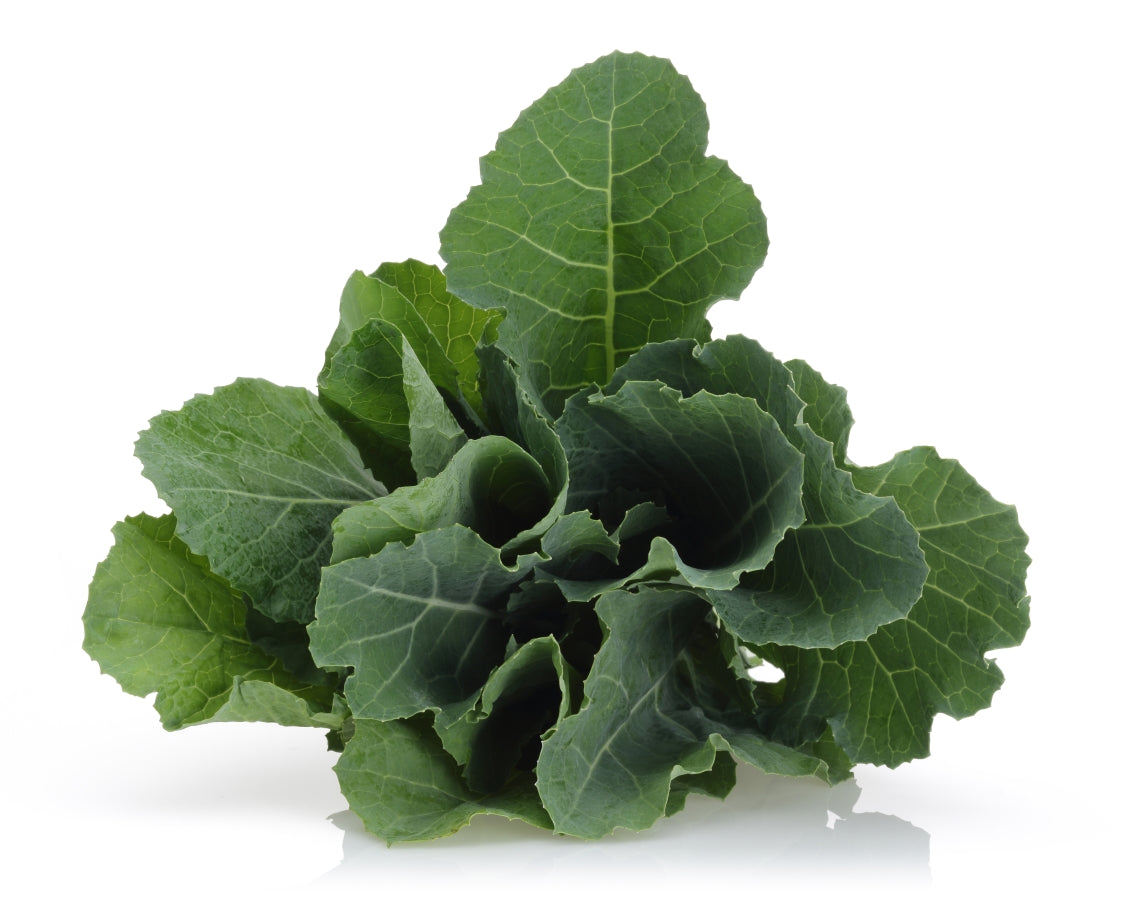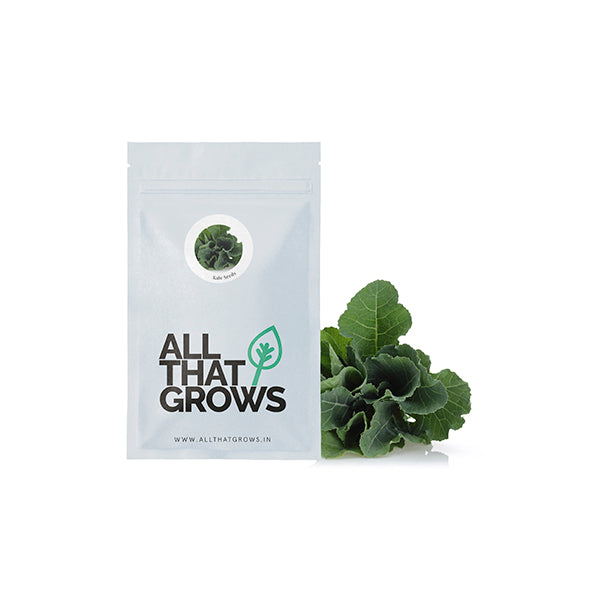



Kale Seeds
Grow this with
Seed Type: Non-hybrid, Open Pollinated & Non-GMO
PLANT HEIGHT : Grows Up To 1.5 Feet High
Color: Green curled leaves with no head
SPECIFICATIONS: Edible Leaves, Suitable For Salad Dressings, Smoothies etc
- SOWING
TIMEMarch- April, Sept-Nov
- Sowing
Distance12-15 inches plant to plant
- Fruit
WeightN/A
- Fruit
ShapeN/A
- Days to
maturity60 to 90 days
- Details
- How to sow
- Reviews
Kale is an incredibly versatile vegetable considering its uses and status in health food. A hardy and resilient member of the cabbage family, Kale is rather easy to grow vegetable and grows well in raised bed gardens and pots. Kale is a variety of Brassica oleracea, known as acephala, meaning “without a head”.It grows best in spring and fall and can even tolerate moderate frosts. Kale has become a superfood ever since the advent of different health diets. The antioxidants in Kale can flush out the toxins and free radicals from the body. The young microgreens of Kale will add an earthy, nutty flavor to your salads while the mature leaves may be steamed, braised, stewed, fried, sauteed, or baked. Kale smoothies are also really popular. Kale is an excellent source of fiber, iron, calcium, and vitamins K, A, and C.
Planting instructions
Kale can be grown directly outside in the gardens or it can be transplanted once the seeds have germinated.
If you start the kale seeds indoors, do the same 5-7 weeks before the last expected frost. If you plan to directly sow the seeds outdoors, do so 2-4 weeks before the last frost.
Because kale is a cool season, hardy crop, it can tolerate winters easily.
Most kale varieties are ready to be harvested within 70-95 days if sown directly with seeds and 55-75 days from the transplanting method.
Growing Requirements
Pests & Diseases
Although a carefree crop, a few insects can still affect Kale. Cabbage Worms, larvae flea beetles, slugs and aphids are the most common insects you may encounter in the gardens. Use a natural pest repellent like neem spray to deter these pests.
soil
Sandy rich, well-drained soil with pH 6.5 to 6.8 is ideal for its cultivation & reduced the chances of clubroot diseases. Keep the soil moist to encourage consistent growth.
Spot
Place in a spot that receives either full sun or partial sunlight. Kale can even tolerate full shade in the gardens.
temperature
The ideal temperature to grow Kale is 18-23°C(65-75°F)
watering
Kale plants like nice and even supply of water ranging between 1 to 1.5 inches per week. Mulching the sown area will also give you a cool and moist soil which is ideal for Kale to grow. Hay and ground leaves can be used as mulch.
how to harvest
Like other collard greens, Kale tastes best when harvested in fall.
Kale can be sown in spring or in autumn for best results. Plant the kale seeds evenly & thinly and cover with a ¼ layer of soil.
Discard leaves which are yellow and ragged. Wash the leaves thoroughly.
Kale grows best with beetroot, celery, cucumbers, onions, spinach, chard, and potatoes. However do not plant Kale next to tomatoes or any type of beans.

The productiveness of any seed we sell is subject to your local climatic conditions*, the sowing method you adopt, and your commitment to the planting process. We give no warranty, expressed or implied, and are in no way responsible for the produce.
Please note that all our seasonal recommendations/ sowing information is as per the local climatic conditions. *For more information on the optimum conditions required for growing seeds in your region, please contact us at, hello@allthatgrows.in or Whatsapp us at, +91 8544865077
Questions & Answers
Have a Question?
Be the first to ask a question about this.




Kale Seeds
Seed Type: Non-hybrid, Open Pollinated & Non-GMO
PLANT HEIGHT : Grows Up To 1.5 Feet High
Color: Green curled leaves with no head
SPECIFICATIONS: Edible Leaves, Suitable For Salad Dressings, Smoothies etc
Grow this with
Kale is an incredibly versatile vegetable considering its uses and status in health food. A hardy and resilient member of the cabbage family, Kale is rather easy to grow vegetable and grows well in raised bed gardens and pots. Kale is a variety of Brassica oleracea, known as acephala, meaning “without a head”.It grows best in spring and fall and can even tolerate moderate frosts. Kale has become a superfood ever since the advent of different health diets. The antioxidants in Kale can flush out the toxins and free radicals from the body. The young microgreens of Kale will add an earthy, nutty flavor to your salads while the mature leaves may be steamed, braised, stewed, fried, sauteed, or baked. Kale smoothies are also really popular. Kale is an excellent source of fiber, iron, calcium, and vitamins K, A, and C.
Seed Type: Non-hybrid, Open Pollinated & Non-GMO
PLANT HEIGHT : Grows Up To 1.5 Feet High
Color: Green curled leaves with no head
SPECIFICATIONS: Edible Leaves, Suitable For Salad Dressings, Smoothies etc
- SOWING
TIMEMarch- April, Sept-Nov
- Sowing
Distance12-15 inches plant to plant
- Fruit
WeightN/A
- Fruit
ShapeN/A
- Days to
maturity60 to 90 days
Planting instructions
Kale can be grown directly outside in the gardens or it can be transplanted once the seeds have germinated.
If you start the kale seeds indoors, do the same 5-7 weeks before the last expected frost. If you plan to directly sow the seeds outdoors, do so 2-4 weeks before the last frost.
Because kale is a cool season, hardy crop, it can tolerate winters easily.
Most kale varieties are ready to be harvested within 70-95 days if sown directly with seeds and 55-75 days from the transplanting method.
Growing Requirements
Pests & Diseases
Although a carefree crop, a few insects can still affect Kale. Cabbage Worms, larvae flea beetles, slugs and aphids are the most common insects you may encounter in the gardens. Use a natural pest repellent like neem spray to deter these pests.
soil
Sandy rich, well-drained soil with pH 6.5 to 6.8 is ideal for its cultivation & reduced the chances of clubroot diseases. Keep the soil moist to encourage consistent growth.
Spot
Place in a spot that receives either full sun or partial sunlight. Kale can even tolerate full shade in the gardens.
temperature
The ideal temperature to grow Kale is 18-23°C(65-75°F)
watering
Kale plants like nice and even supply of water ranging between 1 to 1.5 inches per week. Mulching the sown area will also give you a cool and moist soil which is ideal for Kale to grow. Hay and ground leaves can be used as mulch.
how to harvest
Like other collard greens, Kale tastes best when harvested in fall.
Kale can be sown in spring or in autumn for best results. Plant the kale seeds evenly & thinly and cover with a ¼ layer of soil.
Discard leaves which are yellow and ragged. Wash the leaves thoroughly.
Kale grows best with beetroot, celery, cucumbers, onions, spinach, chard, and potatoes. However do not plant Kale next to tomatoes or any type of beans.



 Sign In
Sign In








